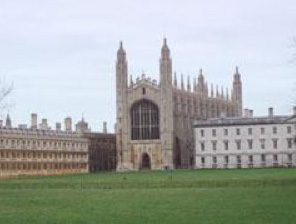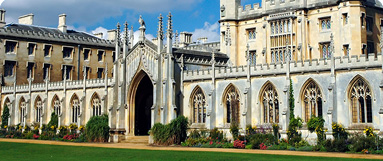Around the World
The U.S. is the most popular destination for students studying abroad, with over 670 thousand students from approximately 130 countries study at American higher education institutions. Universities in the U.S. attract so many people from all over the world because they have firmly established educational philosophies that are based on democracy.
The American educational system is divided into elementary, secondary, and higher education, and is basically similar to that of Japan; however, in Japan, it is uniformly managed by the Ministry of Education, Culture, Sports, Science and Technology, whereas in the U.S., it is up to each region to decide on what is taught and how schools are managed. Hence, the system of education is different depending on the region.
Education in the U.S. focuses on reinforcing student’s uniqueness and developing their talents. In higher educational institutions, emphasis is placed on practical learning, and in undergraduate courses it is possible to learn about liberal arts whilst developing practical skills. Also, a wide range of forms of education is offered, creating an environment that is ready to accept any type of student who is willing to learn.
Moreover, an advantage of studying abroad in the U.S. is that you can choose your major and courses from a wide variety of areas, and study flexibly. Many university-level subjects that are not taught in Japan are available, attracting students from around the world who want to advance their careers by becoming not only global citizens but experts in their fields.
After completing an undergraduate course in 4 years, you are normally awarded a Bachelor’s Degree. In the first two years you will mostly take subjects from a variety of different fields, and since you begin specialized study from the third year, there is no need to select your major from the first year. There are around 2400 public and private universities, including those that focus on research and offer master’s courses, those that focus on liberal arts, and those that specialize in subjects such as art. Liberal Arts colleges represent traditional American education, where a wide range of knowledge can be acquired through thorough instruction in small-size classes.
There are approximately 1700 private and public 2-year universities, and you are awarded an Associate Degree upon graduation. Community Colleges are the most well-known public 2-year colleges, and there are around 1100 of them. Generally they offer various educational programs to local residents, and are characterized by their affordable tuition fees and by the wide age range of the students. On the other hand, private 2-year colleges are called Junior Colleges, which have excellent facilities including dormitories, give thorough instruction to small-size classes, and offer a liberal arts program that will assist students to transfer to a 4-year university.
In the U.S., transfer systems are used quite frequently, and about 40% of U.S. students studying at a 4-year university transferred from a 2-year university. Compared to 4-year universities, 2-year universities present less of a hurdle to get into, have affordable school fees, and have “at-home” atmospheres, which makes it easier for study-abroad students who may not feel confident in their English abilities to settle in. However, the criteria for transferring credits differ depending on where you intend to transfer, so care must be taken.

In Canada, there are various education systems depending on the province/territory and university, and is managed by different educational institutions. For instance, in Quebec, you may not be able to fulfill requirements for applying for an undergraduate course just by having graduated from a Japanese senior high school. It is therefore necessary to do some research on the province/territory that you are thinking of studying in.
Canada’s higher education is separated into graduate schools, 4-year universities, 2-year universities, and university colleges. In particular, university colleges are unique to Canada, combing 2-year universities and 4-year universities. Transfer programs to 4-year universities are readily available, and depending on the department, there are courses that offer 4-year university graduation qualifications.
Canada has approximately 90 4-year universities and 170 2-year universities. The levels are equally high among the 4-year universities, and a high degree of English proficiency will be necessary for overseas students. Moreover, since the admission requirements and system of schooling differ depending on the province/territory or university, compared to the U.S., it is not so easy to transfer to schools in other provinces/territories or transfer credits. Most universities have 2 or 3 semesters in a year and the school year begins between August and September.
If you are planning to study abroad in Canada, it is vital that you thoroughly research the various systems according to the province/territory that you wish to study in.
Community Colleges in Canada were influenced by those in the U.S., and thus many similarities can be seen. Focus is placed on job training and lifelong learning for local residents. Currently, there is a nationwide organization called the ACCC (Association of Canadian Community Colleges) with 150 member schools.
Course programs include those that focus on job training, much like American junior colleges, as well as those that focus on applying to universities. In particular, there are 10-week programs in the job training course where you can acquire a variety of diplomas and certificates. It is also possible to study abroad without the intention of getting a degree.
However, a score of 80 or above in the TOEFL ® iBT is required for admission.
There are 3 types of schools.
1Universities where a bachelor’s degree can be acquired through mostly undergraduate study
2Graduate schools where a master’s degree can be acquired through graduate courses
3Universities where Ph.Ds can be acquired through doctor’s courses
Universities with graduate schools are mostly those located in the city, have excellent facilities, and the education provided is high quality by world standards. According to the Gourman Report, which ranks the top universities in North America, in the Engineering department, 4 Canadian universities rank in the top ten. Those are: The University of Toronto, the University of British Columbia, McGill University, and McMaster University.
Degrees from Canadian Universities are seen as valuable as those from U.S. and U.K. universities.
| English Level | TOEFL®iBT 80~100 | |
| Other Requirements | Academic transcript of your last three years at school (Application fee of Canadian$40~$100) | |
| Tuition | Canadian $ 7,000~17,000 per year (depends heavily on province/territory/major)Additional Canadian $1,000~3,000per year for textbooks and outdoor activity fees. | |
| Accommodation | Dormitory(Room for two with meals) | $ Canadian 4,000~8,500 (eight months) |
| Homestay | $ Canadian 550~900 per month | |
| Apartment(Room for one, furnished) | $ Canadian 300~700 per month(not including meals and utilities) | |
| Apartment(Room for two, furnished) | $ Canadian 300~500 per month (not including meals and utilities) | |

Not only does the UK have universities with a long history and tradition such as Oxford and Cambridge, but also universities in Scotland including Edinburgh, Glasgow, Aberdeen, and St Andrews, as well as the Redbrick Universities that were established in rural areas and cities in the 19th century. In addition, there are even universities established after 1992 when a revision of the laws made allowances for them to diverge from traditional educational institutions.
The education system is unique and different from that of Japan, and is renowned for offering a high level of education.
Compulsory education ends at age 16 in the UK (students then take the GCSE), and those who want to study at university move onto the Sixth Form, and at the end of high school must take the GCE-A. Whether or not you are admitted to your university of choice will normally depend on the results of these 2 tests (GCSE and GCE-A).
In the UK there are approximately 110 universities, all of which are national universities except one private university. Universities in the UK focus only on research and education of major areas of study, and it will normally take 3 years to complete a course. Thus, it is not possible to enter a university immediately after graduating from a Japanese high school― study aborad students need to take specialist courses first.
In order to prepare for university, there are “A-Level Courses” and “Foundation Courses”. In order to get into top universities such as Oxford and Cambridge, it is necessary to study the same “A-Level Courses” as high school students in the UK. When applying to other universities, it is necessary to take the “Foundation Courses” to build up your knowledge in your major field of study, learn how to take classes at university, and develop your language skills.
In some universities, if you complete a Diploma course (equivalent to first year study at university) and fulfill certain requirements, there are programs that allow you to enter university from the second year.
Other than the University of Buckingham, all universities in the UK are national universities. Courses offered include Bachelor of Arts (Linguistics, Art, Social Sciences), Bachelor of Science, and Bachelor of Engineering, among others.
There are exceptions, but normally, a Bachelor’s can be attained in 3 years. In the Linguistics courses, you will study overseas from the second year to the third year. In some universities, in the Business and Management courses, you will undergo training at workplaces while taking regular classes in what is known as a “sandwich course”. In Scotland also, a Bachelor’s course normally takes 3 years to complete.
An Honours Degree will require 4 years, and for students who fulfill particular requirements, it is possible to transfer directly into the second or third year of university.
The requirements for applying for an undergraduate course in the UK depend on the university and courses. For students who studied in the UK, the GCE-A and Scottish Higher grades will be considered, and there are cases in which other requirements regarding major subjects need to be met.
For students who studied in Japan, and want to directly apply for an undergraduate course in the UK, the following will be the most common cases:
• You have already graduated from university
• You have been studying at university for 1-2 years
• You have graduated from a junior college
After graduating from Japanese high school, you will take a university preparation course before starting university. This preparation course serves to fill the gap between the qualifications you gained as a student who graduated from a Japanese high school, and the qualifications needed to enter the undergraduate course, and normally will last 1 year. This course can be taken at the university or college you want to study at, or at one of the many specialist schools, tutorial colleges, and English schools that can be found in the UK.

Australian universities have a reputation for offering a high level of education. In the World University Rankings, 12 out of Australia’s 39 universities rank in the top 100. Being a multicultural country, it also puts emphasis on international education, and actively accepts overseas students.
Higher education in Australia is strictly managed by state and territory governments, the federal government, and the organization “Universities Australia”, and thus the level of education and research activities are highly regarded around the world.
There are 39 universities in Australia, and all but two are public universities. They offer global learning environments and have ties with approximately 4500 universities around the world, providing exchange programs for educators and students.
The school year begins between the end of February to mid-March, comprising of two semesters, and ends in November. In Australian universities, students start studying their majors from the first year, so students who want to study abroad after graduating from high school in Japan usually take a foundation course first.
Each year, over 160,000 overseas students learn from experienced professors who conduct high quality classes. In addition, many universities have ties with high education institutions around the world, offering many overseas programs, and there are more than 70,000 students outside of campus who receive long distance education.
In the education system of Australia, the liberal arts course that universities in Japan offer is completed by the end of high school, and after graduation students are expected to have the foundational knowledge needed to start studying their majors.
At university, students immediately start studying for their majors, but in the foundation program, overseas students will receive guidance about the terminology used in classes, how to conduct discussions and research, how to write papers, and study skills.
Other than undergraduate courses that are similar to Japan’s 4-year courses, courses including Diploma and Advanced Diploma courses are offered for those who want to learn practical skills. In the 2-year associate degree courses, it is possible to transfer to undergraduate courses after learning about the fundamentals and theories of one or several specialist fields. Of course, finding employment after completion is also an option.
Normally, bachelor’s degrees may be attained in 3 years, but it will depend on the university and/or course. In particular, Science courses such as Medicine, Architecture, Engineering tend to take 4-6 years to complete.
Unlike standard universities, these are special institutions that mainly offer practical education to help find employment.
It is possible to attain a Bachelor of Arts, and there are also Diploma courses that can be completed in 2-3 years. Students can learn many skills such as computing, secretarial work, designing, and photography in the Associate Diploma courses that last for 2 years. It must be noted that students have to choose whether to take the Degree course or the Diploma course upon entering.
Most universities begin classes at the end of February and end in late November, and the year is divided into 2 semesters. However, there are some that have 3 semesters a year, and some that have summer school from December to February.
The first semester in two-semester universities begins in late February and ends in late June, and the second semester beings in late July and ends in late November. Class registrations need to be made at the beginning of the academic year, and there are end of semester examinations. Depending on the course/university, if you have enough credits or fulfill requirements, you may be able to start studying from a semester of your choice. For those who wish to start studying from the first semester, the application deadline is October, and for those who want to start studying from the second semester, April is the deadline.
Technical and Further Education
TAFE is a special public institution that focuses on vocational education that allows graduates to begin work effectively immediately after entering the work force, and there are currently 232 TAFE institutes. They are similar to Japan’s private vocational schools. Certificates are awarded after completing a 1~2-year course, and some institutes offer Diplomas, Associate Diplomas, and Bachelor’s Degrees (BA).
In general, Australian students who stop studying after the first half of high school (the end of compulsory education) enroll in TAFE institutes.
The education system in New Zealand is based on that of the UK, and is managed by the national government, making it possible to standardize the level of education. In order to go on to university, a Level 3 in the NCEA (National Certificate of Educational Achievement) is required. All universities are national universities, and each has its own specialty.
 Program for Entering International Universities in Japan
Program for Entering International Universities in Japan-
CLOSE
 For Students Living Overseas
For Students Living Overseas-
CLOSE
 What is e-school?
What is e-school?-
CLOSE
 Program for Entering Overseas Universities/
Program for Entering Overseas Universities/
Graduate Schools-
CLOSE
 For Students Living in Japan
For Students Living in Japan-
CLOSE







